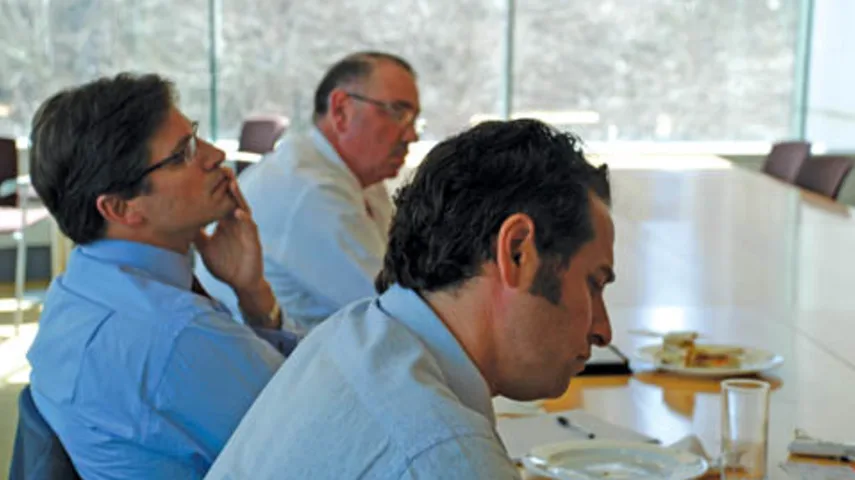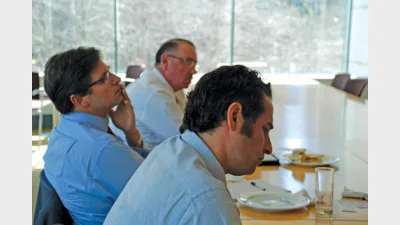Research house round table: balancing business interests with integrity



The filtering of product information by dealer groups and perceived conflicts of interest were contentious topics at the recent Money Management round table.
Present at the round table
NG: Norman Graham (managing director, Lonsec)
DW: David Wright (director, Zenith Investment Partners)
LM: Leanne Milton (head of funds research, Standard & Poor’s)
M Thom: Mark Thomas (chief executive, van Eyk)
AB: Andrew Bird (chief executive, Morningstar)
MT: Mike Taylor (managing editor, Money Management)
MT: One of the things David sort of referenced on his way through a little earlier was the manner in which some of the dealer groups choose to use your data and whether in fact their planners are seeing everything that you’re saying to them. I must say that I was quite astonished late last year when someone told me how the interface between a particular ratings house and a dealer group was working. So I just wonder whether you think it is really a good thing that some of these dealer groups do filter, if that is the right word, the information you’re providing them?
DW: I personally don’t, no. I’m dead against it. I would have thought the dealer groups are employing us for a reason ... You sit down with the dealer group and gain an understanding of what their requirements are from a portfolio perspective and an investment committee and so forth. But you sort of filter the information. Once you’ve done it, to filter the information, that that is then accessible to the advisers I think is very dangerous and, from experience, has let the adviser down ultimately.
AB: I think you need to separate information too, which I agree should be pretty broad. It is one thing to give open slather access to that information. Obviously they won’t have controls on the portfolio construction side or suitability, and you can understand why they need those and it is appropriate to ensure quality of advice, but those are two separate things really.
M Thom: Our role is to provide them with a scale. Some clients will set the scale of acceptability at one down, two down, three down; I think it is their right to do that. I don’t know if I agree that they can muck around with the filterings. So long as they don’t modify their access point or have too many exceptions to the rule — and I think that is what you’re getting at David — I think the issue is they should have a scale, not a number of scales from which they pick and choose. So [having] multiple suppliers of research going out there and finding the best rating for a product so that it can go on a APL [Approved Product List] because they want to do business is, in our view, probably not the best way to go. However, setting their bar and sticking to it is another way that we suggest they should ...
NG: I agree with Mark’s comments. In sitting on some of the investment committees and seeing the exceptions that they do make to the list, not a lot, but sometimes you look at it and wonder why. I know that some of those examples were particularly in things like MISs [managed investment schemes] for whatever reason. I don’t know what they were. But it did have some fairly significant consequences.
M Thom: Some clients own product as well.
NG: And the classic cases of that were in the MISs, with the two big ones being Great Southern and Timbercorp.
DW: It still amazes me that there are dealer groups out there that don’t subscribe to any research and operate their APL based on the research they are able to …
DW: They run their APL and dealership based on research reports they are able to get direct from either the fund manager or the product provider. Surely that can’t be compliant, but it happens, and it still happens quite frequently.
MT: Would it be possible to draw a link between some of the damage that has been wrought out there in investment land and the people who don’t specifically subscribe to a ratings house?
DW: Possibly. I can’t point to a specific example, but no manager or product provider is going to provide the report again for a dealer group if the report is negative, if there is a redeem or switch recommendation. So that part of that model itself is totally flawed because you’re not getting continuity of research, let alone anything else.
LM: If you’re doing it like that you’re not even getting any key relativity or understanding of the sector or what else is out there. That is just fraught with dangers.
MT: One of the things that, as journalists, we quite frequently sort of raise our eyebrows at and probably don’t fully understand is the different models that each of you utilise. There is some commonality, but essentially money changes hands in terms of ratings or there is a commercial transaction involved in some point of the process. And I guess in the minds of the public, they would say, well, how relevant is a rating if a fund manager paid to be rated? So how do you deal with that perception out there?
LM: I think that is a good one because we’re with one of those research houses where we pay for the rating, but I think it is how you manage them. [In any sector or any industry, it is how you manage those conflicts of interest.] Some research houses manage money. That is another conflict. It is really about that and your business rules and compliance … segregation of duties, all those sorts of things that you put in place to make sure … the conflicts of interests are managed. We put that out very regularly. The research teams have no idea what a fund manager will pay for a rating. That is a completely separate chain. We don’t get involved in that whatsoever and should not know and do not know. We’re there to do our job; that is a firewall that has been put in place and it is very clear. There are other ways people might manage conflicts if they manage a product.
NG: I agree with Leanne. To me, this whole question of independence, it is bigger than just product coverage or getting paid by a funds manager or getting paid by a client to give advice to them or selling a property or refereeing a game of footy when you used to barrack for the opposition.
Within reason, in this day and age we believe it is a cop out because if you’re a director of a company, and two of us are, if you’re an RE [responsible entity] or an RO [registered officer] of a company, which a few of us are, you’ve got the Corporations Act, you’ve got ASIC [Australian Securities and Investments Commission], you’ve got AFSLs [Australian Financial Services Licences], you’ve got everything else ... We as individuals know that if we do something that compromises your independence or compromises the integrity of the product and conflicts your client, we can end up losing everything.
Now if you’ve got personnel who you employ, you employ them to be able to do a job. If they allow themselves to get conflicted in some way, shape or form, that will end up coming back to us as the manager. So it is a matter of how you manage it. And if anybody is involved in making a recommendation and they are being managed by somebody, that manager is aware of the obligations under the AFSL, ASIC, Corporations Act, every damn thing possible.
Now I don’t think there is anybody around this table who would get paid for writing an article negatively about AMP, [but if] you’ve got an ad for them in the same paper, is there a conflict there? Every time you write something positive about somebody in the industry and you run an ad for them, does that mean you shouldn’t run that positive story because all of a sudden you’ve been corrupted? I get quite emotive about this because if you’ve got staff who have integrity and professionalism, and that is what it all boils down to, it shouldn’t be an issue of independence because everybody has to get paid for a service.
LM: That’s right, I agree. Our analysts are incensed by that because their names are on those ratings reports. It is their reputation and the quality of their research that is being questioned.
M Thom: I don’t think it is a matter of the individuals being put under question. I think it is a matter of whether the process is conflicted or not. At the end of the day, if you had a pay-for-ratings model, your client is the fund manager, if you have a subscription model, your client is the end user. Whether that translates into who owns the intellectual property of that report or not is something I don’t fully understand, although I would imagine where the fund manager is the client that they would own the intellectual property, but you can answer that one. So in that situation, the intellectual property, it is not about the rating, it is about how one tells the story to get to the rating and how malleable some of those words might be. And that is something where our people are not under that pressure, and that is what I’m saying in terms of the process.
The other point I want to make is the universe that you are researching, if you’re not relying on a commercial transaction to occur to include or exclude somebody from a universe, I think there is far less pressure on your process as well. So we can go and spend time with a boutique that has no representation and no marketing budget whatsoever in the Australian market because we like that sector or that manager, and that is our choice. So we’re delivering stuff to our clients that is, in our view, under a process which has less pressure on the analyst, and I think that is the key. The issues around people acting as directors, I completely agree with those comments because everybody is under enormous scrutiny in this highly regulated market.
LM: I think the ASIC inquiry into research houses and ratings agencies, of which we are both, I think at the end of the day ASIC wants to come into research houses and wants to know how you’re managing your conflicts of interest. If you can demonstrate that, I don’t think there is an issue.
DW: I think that is right. Wherever there is a commercial transaction there is a potential conflict of interest. It doesn’t matter whether it is paid for ratings, it doesn’t matter whether it is managing product, it doesn’t matter whether it is managers paying to participate in conferences. It is how you manage those conflicts.
NG: [If there are] commercial transactions anywhere [it] can then be argued that it is conflicting the independence of whatever that service is.
M Thom: Can you explain to me the difference between managing money under a multi-manager and the conflicts that arise out of that and suggesting a model portfolio, because I don’t see how there is any difference between those two conflicts if there was a conflict — and I don’t think there is a conflict.
DW: But there could be a kind of conflict, Mark. If your model portfolios mirror the multi-manager, you’d hope that they would.
M Thom: But just doing one or the other, are they different firstly? There might be conflicts in front running research and stuff, and you need to manage that. I accept that is probably one of them.
NG: Which I would have thought is a very major and potentially catastrophic ramification.
M Thom: Sure, that is why you need to have rules around that stuff.
NG: But the same influences could …
M Thom: As an example of that, we downgraded Basis in May of 2006 and we didn’t pull out until July, but we pulled out over 18 months as a part of that thing. So you’ve got to have rules, I agree, definitely.
NG: And that is the crux of the issue when it comes to independence, how stringent those rules are, how they are implemented and how they are governed once they are in place.
Now, as I said, there can always be exceptions and it doesn’t matter whether it is in 10 years’ time or 10 years’ ago, there is always going to be an exception somewhere. It could be a stockbroker doing a recommendation on a direct company that goes belly up two days later or two weeks later and they’ve raised some money for them. Where is the conflict there? But they can get away with it because under the law, as long as you can prove you’ve done your due diligence and you haven’t done it fraudulently or misrepresented it, you can make a recommendation and not be harassed for it.
Now, at the moment, how you implement those compliance regimes internally, that should be the filter for what is independent and what is not. Because the obligations, and it doesn’t matter whether you manage money and get something in or out of it first or not, or if we recommend a model portfolio or not, there is always going to be a situation where you’ve got to review that. And if you’re dealing with a client and they want to change the provider of the model portfolio, that is their choice and they can change that when they want to. They might want 43 model portfolios, [but] they can have their choice in that. They might have five options or whatever under a multi-manager. That is their choice. But to govern the conflict and the independence is an internal requirement that has to be done by individuals, and that is where the whole debate is getting skewed. I would like to ask the industry generally and the regulator if they can go out and identify somebody who has fraudulently made a recommendation because of a brown paper bag in the last five, six, 10, or 12 years?
DW: We could probably sit here and talk about the merits of each others’ business model, but I’m not sure that is really the issue. I don’t think the industry fully understands the cost of producing and providing research, so you go to advisers. The majority of advisers, let’s face it, will not pay what it costs to enable research houses and even asset consultants. You look at asset consultants’ business models — your Russells and your Intechs — they have all got implemented businesses, their own product. So in the Australian market it is virtually impossible to survive as a research provider or asset consultant unless you’re charging for ratings or you’re managing a product.
AB: I agree. I think the biggest issue there is that people don’t want to pay the true cost of research. And all of us have had to come up with some means of making it work. We don’t charge managers, but we recognise there are conflicts in all sorts of possible business models. I think some are easier to manage than others, I’d say that much. At the end of the day, the issue is if you want good research or good information, someone is going to have to pay for it. And the more the investor is paying for it, I think the better off things will be ultimately, but the investor has got to want it and be willing to pay for it.
NG: Research is a commodity. The intellectual property and the value is in actually creating that commodity. But once it gets published, anyone can access it.
M Thom: The other thing is, I agree, the costs of research have risen significantly in the last three to five years. Take doing a review of equity managers. In the old days there were just 25 of them and they were all similar. Now you’ve got long/long, you’ve got concentrated, you’ve got 130-30, you’ve got variable beta, you’ve got income specialisation, you’ve got small cap, you’ve got emerging market and you’ve got infrastructure. There are 10 equity reviews you’ve got to do, and that is just for the core part of the portfolio. Quite separate to that, you’ve got the global counterparts. So we’re spending half our time overseas; we’re sending three people on three separate trips this year around the world reviewing managers for 20 days and then coming back, and that is just part of it.
The other thing is the monitoring that is required is far greater these days. The point that I’d also make about the cost of research, we’ve got a very profitable research business. I think for us it is not so much did we need a multi-manager to make ends meet, it was the scale of our business, provided we could manage the conflicts. You reach capacity or a point of saturation in terms of your market share and you’ve got to say we’ve got this intellectual property, we can continue to do that or we can apply it to another channel. And that is what we chose to do. In fact, the undertaking to go and supply a multi-manager to the market is much greater than for research because, as you know, with research it is usually with the big group’s head of a sale and head of a servicing model. So at the moment our multi-manager is probably not spitting out the money. It is the research business that is the cash cow.
NG: And then you need to do the research to do the selection of the multi-manager product anyway.
M Thom: Of course, yes. So I mean it is the same intellectual property, it is just how you package it and distribute it. But certainly I think it is more to do with the business model and where you see the growth in your business. And a big part of that is attracting quality staff. If you do have a multi, we found you can attract people who are interested in applying, and it works both ways.
AB: We’d agree with that. We’ve joined the space with our acquisition of Intech and we’re still grappling with that integration. But yeah, I think some of the themes that Mark talked about apply to us as well.
DW: It is a bit of a resourcing skill set. Let’s face it, we compete with every other part of the industry to attract and retain people, so at the end of the day, if you’re competing on a remuneration perspective you end up losing experienced and skilled people. There is probably not too many people in research who have been in research as long as we have, and the reason for that is they have gone elsewhere, historically after gaining experience through research.
M Thom: A lot of people say, ‘Who are your competitors?’, and I answer, ‘Which channel are you talking about?’ It’s like if we’re talking about ratings there is this peer group here. If we’re talking about asset consulting there is a peer group. If we’re talking about fund to fund it includes BT, Mercer, Colonial and whatever. So I think, again, it is the same intellectual property. Consulting would be another group. So it is about trying to leverage our intellectual property, provided we do that with professionalism. And that is why we’ve spent a lot of money on compliance. We’ve got a very strong in-house group doing that sort of thing. I think the positive of regulation is that there are a lot of checks, but there is also a significant barrier to entry.
DW: Mark, I’d be interested in your view on the consulting side, consulting to fund managers going forward, that sort of work. Do you reckon that is dead as a result of what is likely to happen?
M Thom: The work that we do with managers is more around them sourcing best of breed components. It is not really around product development. And, in any case, we have rules around that. If we do consulting on a product, and we haven’t done something for a long time, but if we do something around that there would be a 12-month period where we couldn’t rate them, and they are different teams as well.
DW: We’ve done the same sort of thing. Perhaps one of the things that [former Minister for Superannuation and Corporate Law Nick Sherry] did mention and drew parallels with were credit rating agencies and their consulting in terms of collateralised debt obligations and so forth and then rating them. That is an area that is going to be knocked on the head. I don’t think we’re going to be able to operate in that space ...
M Thom: One of our consultants told this story at our conference. Investment banks would go along to the ratings agencies and they’d show them their algorithm for their latest securitised product. And they said, ‘If the guy sitting across the table understands you, if he understood it, you hire him, and if he didn’t understand it, you’d probably give it a good rating’.
This is an edited transcript of the round table.
Recommended for you
Unregistered managed investment scheme operator Chris Marco has been sentenced after being found guilty of 43 fraud charges, receiving the highest sentence imposed by an Australian court regarding an ASIC criminal investigation.
ASIC has cancelled the AFSL of Sydney-based Arrumar Private after it failed to comply with the conditions of its licence.
Two investment advisory research houses have announced a merger to form a combined entity under the name Delta Portfolios.
The top five licensees are demonstrating a “strong recovery” from losses in the first half of the year, and the gap is narrowing between their respective adviser numbers.











